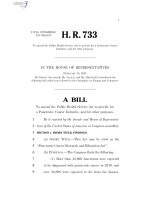Branding the Public Service E
Bạn đang xem bản rút gọn của tài liệu. Xem và tải ngay bản đầy đủ của tài liệu tại đây (465.89 KB, 28 trang )
Branding the Public Service of
Canada
December, 2007
Contents
• What are brands, purpose and PS branding
• Developing the brand: approach, steps and
timeline
• Building the brand
• Early initiatives
• Next steps
• Branding initiatives underway
2
Purpose of this presentation
Develop a shared understanding of branding, propose key actions, timelines and next
steps in developing a brand for the Public Service of Canada
3
What is a Brand?
• A brand is “promise” future employees, employees,
consumers, clients, citizens believe in.
– Branding is much more than a logo, a tagline or a
slogan
• Branding is:
– A 360˚ look at every aspect of the organization
– Every touch point with members of the
organization’s target audiences (external and
internal)
• Branding requires consistency, clarity and
commitment
4
Some Facts about the Public Service
•
•
•
•
•
•
•
•
•
•
Canada’s largest employer – approximately 250K employees
Canada’s most national employer – 1,600 points of service across
Canada
Canada’s most international employer – present in more than 150
countries
Offers over 1,000 different types of jobs
Offers real opportunity for advancement – 36 CEO-equivalent
positions and over 4,500 executives
Works in many different lines of business (economical, social,
cultural, scientific)
Delivers vital services that touch citizens’ lives every day
Has a direct impact in the country and in the world
Average age of a new indeterminate employee is 36 years
Average age of new EXs is 46 years
5
Branding in Government Organizations
•
•
•
•
•
•
•
•
•
Canada Post Corporation (CPC)
Canadian Blood Services (CBS)
Parks Canada (PC)
Canada Mortgage and Housing Corporation
(CMHC)
Canadian Museum of Civilization
Business Development Bank of Canada
Farm Credit Canada
CRA, DND, RCMP
Province of British Columbia
6
Why a Branding Strategy for the
Public Service?
•
•
To support government’s plan for a stronger Canada
To support one of the key objectives of the government to
strengthen and promote Canada’s foundational values of
freedom, democracy, human rights and the rule of law
• To build employees’ trust and pride, and encourage them to
act as ambassadors for their organization, its values,
products and services
• To attract and recruit qualified new employees
• To reflect government’s efforts in ensuring that the Public
Service meets the evolving needs of Canadians and the
Canadian society with excellence in policy development
and advice, and professional service delivery
7
Why now?
• Demographics and labour market urge to
position the PS as an employer of choice
• Commitment by Clerk in PS Renewal Action Plan
• 100th Anniversary of PSC and 140th Anniversary
of the PS in 2008
• Recommendation by the PM Advisory
Committee on PS
• Suggestions made by the Senior Level
Committee on Retention and Compensation
8
PS Branding and Sub-brands?
Public service branding needs to be flexible to
allow for strong complementary sub-brands
“customized to suit the particular needs and
circumstances of individual departments
and agencies or functional communities”.
– Some departments (e.g. CRA, DND, RCMP, etc.) have
developed and are implementing a brand with emphasis
varying from recruitment (DND, RCMP) through to business
development (CRA).
9
Mission
(options)
1.
2.
3.
4.
5.
6.
Serving the public and the public interest
Canadians serving Canada with excellence and
pride
Canadians serving Canadian interests
Serving Canadians
Serving the public interest
Dedicated to excellence in public service
10
Vision
(options)
1.
2.
3.
4.
5.
Building a strong Canada
Keeping Canada strong
Make Canada better
Building a country that is a source of pride
Contributing to Canada’s advancement
11
Approach
The development of an overall umbrella brand for the PS with brand segments for all four
main components (recruitment, internal, Canadians and Parliamentarians)
Branding Model For the Public Service
PS UMBRELLA
BRAND
Audience Segment #1
Prospective Employees
Audience Segment #2
Current Employees
Audience Segment #3
Canadians
Audience Segment #4
Parliamentarians
Students
New Graduates
Individual
Public Servants
General Public
Mid-Career
Senior
Management
Managers
Influencers
Members of
Equity Groups
Education
Institutions
Individual departments
/ agencies
Functional
Professionals
Audience Segment #5
International
Business
Leaders
Functional
Communities
Community
Leaders
Unions
Academia
APEX
NGOs
Media
12
What to Brand for?
1. Prospective Employees
Attract qualified prospective employees that share our common
values and ethics to join the Public Service of Canada
2. Current Employees
Reinforce a culture of pride and engagement across the PS where
each employee can exercise their full potential in a workplace that
is healthy, rewarding, high performing, supportive, challenging,
professional and adaptive
3. Canadians
Strengthen the PS image with Canadians at large to build trust in
the institution
4. Parliamentarians
5. International Community
13
Approach with our Value
Proposition
1.
Holistic – cannot be
only about recruitment
or culture
2.
Consistent and
coherent
3. Integrated – to
resonate with prospective
employees, current
employees and citizens
14
Development Process
1.
2.
3.
4.
5.
6.
Intelligence gathering, analysis and consultations
Discuss branding approach, lessons learned, identify key
contacts, etc.
Presentation of preliminary findings and approach to DM PS
Renewal Committee and other senior-level committees
Public tender and engagement of a professional firm
Development of the PS-wide branding strategy
Engagement of key stakeholders (DMs, DG
Communications, Managers’ Community, Unions, Youth,
HRMAC, etc.)
15
Engagement and Outreach
Development of an engagement and outreach strategy to
include:
•
•
•
•
•
•
•
•
•
•
Volunteers
Development of a Working Group of DGs representing
departments agencies
Regional Federal Councils
Youth network
Functional Communities
Managers network and Conference
Communications community and Conference
Communications strategy for external audiences
Dialogue with key stakeholders on best practices in branding
Presentations to senior-level committees: DMs PS Renewal
Committee, Communications Council on PS Renewal, DGs
Council on PSMA, Regional Federal Councils
16
Timelines
A: Define the PS Brand
Approach
Timeline
B: Build the Brand Strategy and launch
a series of early initiatives
PHASE ONE
Internal Analysis
PHASE TWO
Research
Values
Intelligence gathering
Creation of committees:
Research Gap Analysis
Confirm branding
objectives
Conduct executive
research
Conduct employee
focus groups
Conduct
stakeholder
research
- Working Group
- Steering Committee
- Advisory Committee
PHASE THREE
Strategic Planning
Identify the
opportunity
Develop brand
platform, promise
and character
Establish and test
PS positioning
Consult with DMs
Committees
Develop and test
brand identity
Develop
implementation
framework
PHASE FOUR
Brand Strategy
and complete
Implementation
Planning
C: Start the Implementation, Live the
Brand and Monitor
PHASE FIVE
Implementation and
Evaluation
Develop/finalize
brand strategy
Develop/finalize
internal/external
implementation plan
Implementation
Jan 08 – Mar 08
April 08 and on
Evaluation
Early Initiatives
PS Renewal Activities
Aug–Sep ‘07
Sep 07– Jan 08
17
Issues and Challenges
• Brand has to be relevant to our targeted
prospects, our employees and Canadians in
general
• Diversity of the Public Service
• Positioning and Messaging
• Managing and sustaining the brand
18
Sustaining the Brand
Managing the Brand
•
•
•
•
•
Requires strategically-driven
senior management leadership
and commitment (e.g. Clerk and
DMs) to ensure success
An accountability mechanism to
make sure “we walk the talk”
Engagement and buy-in by
opinion leaders at all levels
across government (including
bargaining agents)
Generate buy-in and bring the
organization and its various
components into alignment with
the brand (I.e. deliver on the
promise of the brand)
Monitoring and assessing the
brand performance
•
•
•
•
•
Holistic and consistent
approach
Change of government
direction
Timing considerations (e.g.
impact on collective
bargaining)
Requires a long-term and
sustained commitment of
resources for implementation
Requires in-place systems to
support and facilitate the
brand (i.e. recruitment and
staffing processes)
19
Linkages and partnerships
•
•
•
•
•
•
Central agencies, PSC, PCO, TBS, Finance
Canadians serving Canadians (e.g. Service Canada)
Department and agencies
Unions
CCO and other reps of functional communities
Networks (Youth, Manager Community, HR Council,
HRMAC, DM PS Renewal Committee, etc.)
• NGOs (e.g. United Way, YMCA, etc.)
20
Benefits
•
Attract highly skilled workers to the PS
•
Motivate, retain and engage employees
•
Strengthening the image of public servants and public service with Canadians
21
Anticipated Results
• Establishing “brand equity” for the organization (e.g.
goodwill and “benefit of the doubt”, useful in times of crisis
or policy change).
• Communicating a set of values that speak to employees,
future employees and Canadians
• Improving the PS and its different entities’ ability to
communicate and internalize its corporate vision and
mission
• Increasing consistency of internal and external
communications
• Provide a strong platform for future policy or program
development and services
22
Lessons Learned from Others
• Branding is a long process, take the
time to brief and re-brief to build
support
• Branding is still misunderstood,
take the time to brief and re-brief to
build understanding
• Use research to “bullet-proof” the
branding work
• Identify and work with a champion
(a high-level champion)
• Focus on the process (logical,
sequential, research-based)
Source: CRA MARCOM Presentation
June 07
•
•
•
•
•
•
•
Conducted significant research (focus
groups and surveys) to clearly
understand the values communicated
by the institution
Ensured brand was consistent with
policy direction
Made sure senior leadership was "onboard"
Ensured consistency through all parts
of the organisation
Make sure brand can be used for all
media - Television, Internet, print,
others
Ensure proper budget to give the brand
adequate visibility
Applications for recruitment increased
from 22K (Sep 06) to 35K+ (06-07); Web
visits increased from an average of
120K/month (04-06) to a record of 1.3M
in March 07
Source: DND, August 2007
23
Actions Completed
•
•
•
•
•
•
•
Established an action plan for the next 18 months and received Agency funding until
end of Fiscal 07-08.
Prepared Request for Proposal (including a Statement of Work) for identifying firm(s)
that will assist in the development of a branding strategy and implementation
planning. The RFP will be published on a public tendering system
Continued to gather intelligence, consulted and held meetings with senior
management and key groups and individuals in various jurisdictions, departments
and agencies – Farm Credit Canada, Government of BC, Canada Revenue Agency
(CRA), Department of National Defence (DND), Public Works and Government
Services Canada (PWGSC), PSC, TBS, PCO, Service Canada, CPSA etc).
Developed and updated a strategic Framework that sets out the key issues and a
proposed approach to branding the PS.
Developed a PowerPoint presentation to complement the Framework and made
presentations to senior-level committees, e.g. DMs’ PS Renewal Committee, DG
Communications on PS Renewal, Human Resource Council, Regional Federal
Councils.
Created three supporting committees comprising a Steering Committee with ADMlevel members, a Working Committee with DG-level members, and an Advisory
Group made of experts from various non-governmental groups such as academia,
private sector, media, Crown Corporations, and held initial meetings
Developed mission and vision statements
24
Next Steps
•
December 2007
–
–
–
–
•
January 2008
–
–
•
Post a Did you Know?
Launch of job shadowing project
Development and finalization of branding strategy
March 2008
–
–
•
Meeting with the three branding committees
Meeting with the Functional Communities leaders
February 2008
–
–
–
•
Gather profiles for the first issue of A Day in the Life/Did you know? Theme: Diversity of positions in PS
Select the company with expertise in branding through the competitive process (RFP)
Final report of market analysis reports
Strategy development for Engagement and Outreach
Second issue of A Day in the Life / Did you know?… Theme: Diversity of locations of jobs in the PS
Testing of Brand promise and character with key audiences
April 2008
–
–
Post a Did you Know?
Completion of strategy and development of implementation and evaluation plans
•
May 2008
•
June 2008
–
–
–
Post a Did you know?
Soft launch of brand during PS Week
3rd Issue of A Day in the Life/Did you know?. Theme: Front line services to the public
•
September 2008
•
June to October 2008
–
–
•
•
•
4th issue of A Day in the Life/Did you know? Theme Public servants receiving national and international recognition
Further development of the brand strategy that will include a PS vision, objectives, positioning, brand analysis, situation/gap analysis, brand
character, brand promise, brand identity, messages, action plan, implementation and evaluation plans
October 2008 and on - Implementation of brand strategy, tracking and evaluation
Ongoing – Engagement of stakeholders, presentations and seminars, outreach, inreach and participation at events such as the 100th
anniversary of the PS Commission and the Public Service week
Ongoing – Continuous tracking and collaboration with various stakeholders to ensure successful implementation and sustainability
25









